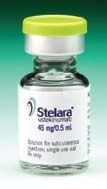Rx Product News Profile: A Closer Look at New FDA Actions: Centocor Ortho Biotech's Stelara
The FDA recently approved Centocor Ortho Biotech's Stelara (ustekinumab)for the treatment of adult patients with moderate-to-severe plaque psoriasis who are candidates for phototherapy or systemic therapy.
Dr. Holmberg is the pharmacy coordinator at Desert Vista Behavioral Health Center in Mesa, Arizona.

The FDA has approved Stelara (ustekinumab), marketed by Centocor Ortho Biotech Inc, for the treatment of moderate-to-severe plaque psoriasis in patients older than 18 years of age who are candidates for phototherapy or systemic therapy.1
Psoriasis is a chronic immune disease that presents with inflamed, red lesions due to an overproduction of skin cells. Lesions usually develop on the elbows, knees, scalp, and lower back and may be painful or bleed.2,3 Although many different forms of psoriasis exist, plaque psoriasis is the most common and consists of about 80% of all psoriasis cases.3 Approximately 7.5 million people in the United States and 3% of people worldwide have psoriasis; about 25% of these cases are moderate to severe.2
Mechanism of Action
Interleukin (IL)-12 and IL-23 are naturally occurring cytokines that participate in inflammatory and immune responses, such as natural killer cell activation and CD4+ T-cell differentiation and activation. Stelara is a human immunoglobulin G1 monoclonal antibody that binds to the p40 protein subunit with high affinity and specificity on both IL-12 and IL-23. By binding to the subunits on IL-12 and IL-23, Stelara exerts an effect that eventually interrupts both their signaling and their cascade.1
Clinical Trials
Stelara was evaluated in 2 multicenter, randomized, double-blind, placebocontrolled studies in a total of 1996 adult patients. Patients included in the study had to have at least 10% body surface area involvement, a Psoriasis Area and Severity Index (PASI) score of ≥12, and be a candidate for phototherapy or systemic therapy. The end point of both studies was the proportion of patients achieving at least a 75% reduction in PASI score by week 12 and treatment success on the Physician’s Global Assessment. Both studies found that a higher proportion of patients receiving Stelara achieved 75% reduction in PASI score than the patients receiving placebo.1,2
Dosage and Administration
Stelara is given by subcutaneous injection and should be dosed by patient weight. For patients weighing ≤100 kg, 45 mg should be given initially and again 4 weeks later, followed by maintenance therapy of 45 mg every 12 weeks. Patients weighing >100 kg should receive 90 mg initially and again 4 weeks later, followed by maintenance therapy of 90 mg every 12 weeks.1
Contraindications, Warnings, and Precautions
No contraindications exist to the use of Stelara. Stelara should not be administered to patients with active infections. Serious infections have occurred during treatment with Stelara; its use may increase the risk of infections and reactivation of latent infections. Patients with a genetic deficiency of IL-12 or IL-23 may be especially vulnerable to infections from mycobacteria, salmonella, and Bacillus Calmette- Guerin vaccinations. All patients should be screened for tuberculosis infection before beginning treatment with Stelara. Patients with active tuberculosis should not receive Stelara. Patients with latent tuberculosis should receive treatment for the infection before beginning treatment with Stelara. Stelara may increase the risk for malignancies. One case has been reported of reversible posterior leukoencephalopathy syndrome during treatment with Stelara.
Patients receiving Stelara should not be given live vaccines. The concurrent use of immunosuppressants or phototherapy during treatment with Stelara has not been evaluated.
Stelara is a Pregnancy Category B drug; however, no clinical trials of Stelara have been conducted in pregnant women. It should be used cautiously in women who are breastfeeding. Stelara has not been studied in pediatric patients.1
Adverse Effects
In clinical trials, the most commonly reported adverse effects were nasopharyngitis, upper respiratory tract infection, headache, and fatigue.1
Patient Education
Patients should read the Stelara Medication Guide before starting treatment with Stelara and at each prescription renewal. Patients should be counseled that their immune system may be less able to fight infections while receiving Stelara and that there may be an increased risk of malignancy during treatment with Stelara.1 â–
References
1. Stelara complete prescribing information. www.stelarainfo.com/stelarainfo/assets/pdf/PrescribingInformation.pdf. Accessed January 2010.
2. Stelara (ustekinumab) receives FDA approval for treatment of moderate to severe plaque psoriasis with four-times-a-year maintenance dosing. www.centocororthobiotech.com/cobi/viewDocumentByTitleAlias.html?title=PR_Stelara Accessed January 2010.
3. National psoriasis foundation. www.psoriasis.org/netcommunity/learn01. Accessed January 2010.

